Ripley Entertainment Inc.'s Blog, page 362
February 14, 2018
Retracing the Real Beauty and the Beast Love Story with Alison Teal
Featured in Ripley's Believe It or Not!

Believe it or not, the beast from a tale as old as time was based on a real story. The beast was indeed covered in hair and regarded by many to be a monster, but just like in the fairy tale, he was eventually able to find love.
Pedro Gonzalez was born in the Canary Islands. Though the origins of his birth remain a mystery, he was eventually taken to King Henri II of France in a cage.
Unsure of what to make of the small and feral looking boy, Henri II decided to try and educate what was a “demi-human” in many people’s eyes. Locked in a barren room, he was given raw meat and animal feed for sustenance.
 The furry boy soon became versed in not just the basics of literature, but in the etiquette of nobility. He quickly became a court asset, attracting ambassadors and foreign dignitaries into his company. He took to wearing lavish robes with high collars to compliment his furry face. No more did he dine on the butcher’s trimmings, but instead the fine dining his royal stewards had to offer.
The furry boy soon became versed in not just the basics of literature, but in the etiquette of nobility. He quickly became a court asset, attracting ambassadors and foreign dignitaries into his company. He took to wearing lavish robes with high collars to compliment his furry face. No more did he dine on the butcher’s trimmings, but instead the fine dining his royal stewards had to offer.
At 17 years old, he was married to a girl named Catherine, who was reported to have been rather upset with her arranged suitor. Much like Belle, however, she was slowly won over by the charms of the furry nobleman. She eventually bore seven children. Two would exhibit the same hairy visages as their father and become token members of other courts.
It was this 16th-century story that is thought to have inspired the 17th-century fairy tale of Beauty and the Beast.
Hypertrichosis
Gonzalez was, of course, not a beast. Rather, he suffered from a condition known as hypertrichosis. An exceedingly rare condition, hypertrichosis is marked by rampant hair growth all over the body.
Pedro Gonzalez is thought to be the first recorded case of hypertrichosis. Since his life in the 1500s, only about 50 cases have been observed. Many have made their way to the world stage through sideshows and circuses.

Fedor Jeftichew was exhibited as a “dog boy” by P.T. Barnum.
Retracing Pedro’s Journey
Alison Teal, known as the female Indiana Jones, recently retraced Pedro Gonzalez’s steps, exploring volcanic caves, underground waterways, and the “beast’s” castle. Though she grew up exploring remote and exotic places as a child, she still managed to catch a few Disney films on transcontinental flights, and—like any young girl—dreamed of being a princess.
Her favorite, of course, was Belle. Now an explorer herself, she set out to the Canary Islands to investigate Pedro’s story. Standing in the land of a thousand volcanoes, she could only imagine what the Pedro must have felt like, captured in a sparsely populated volcanic landscape, then caged and thrust into the colorful court of King Henri II.
“Can you imagine the culture shock, living in a remote part of the world, being loaded on a ship, kept in a cage, and being fed raw meat?”
Making her way from the Canary Islands to France, she located a portrait of Pedro’s daughter, holding a letter about her father’s origins.

Antoinette Gonsalvus
Despite the odds and ridicule he faced, Alison notes that he was eventually given a chance, and seems to have found happiness.
“My jaw dropped when I saw Catherine…According to the historians I talked to, they were painted as people who were very much in love.”

Catherine’s yellow dress.
With a fairy-tale ending, this story stands up to the values Alison internalized as a child.
“Legends and myths are what children are raised on. I don’t hunt treasure, but preserve and keep stories alive to shape the youth of today.”
Alison found her beast but isn’t done adventuring. She told us there are plenty more real-life fairy tales waiting to be rediscovered and to keep tabs on her Instagram.
Source: Retracing the Real Beauty and the Beast Love Story with Alison Teal
CARTOON 02-14-2018
February 13, 2018
College Bros in the 1930s Were the Champs of Goldfish Swallowing
Featured in Ripley's Believe It or Not!

While the Internet’s cinnamon, saltine, mannequin, and ice bucket challenges may be just recent memories, mankind has long been swept up in crazes of daring. Things were no different in the early 1920s. Popularized in American schools, the challenge consisted of swallowing a live, wriggling goldfish whole.
The Great Goldfish Gulper
Some believe it gained widespread popularity when Lothrop Withington Jr. performed the stunt for a student election. Withington was running for class president, when he regaled the student body with tales of his willingness to do anything, mentioning he had once swallowed a goldfish.
Dared to repeat the stunt—and egged on by his friends—he stood before the student body and press to swallow the unfortunate fish. Afterwards, he brushed his teeth and washed it down with a dinner of fried fish and tartar sauce.

“The scales caught a bit on my throat as they went down.”
The press spread the story like wildfire, even giving him coverage in TIME magazine. Before anyone knew it, students all over were swallowing goldfish. But proving you could swallow a goldfish quickly wasn’t enough, and the true test of their medal was just how many you could swallow!

In a bit of Ivy League competition, a student was able to swallow 25 fish, but it was Albert Hayes of the Massachusetts Institute of Technology that claimed the record holder for “piscine delegation” when he downed 42 slippery fish. It took him nearly a minute each to get the fish down, as it was reported that he had trouble keeping them from hopping out of his mouth! This record was apparently smashed by Joseph Deliberato who swallowed 89 goldfish at Clark University shortly after.
The Law
Unlike many fads that die out on their own, it took legislative action to stop goldfish gulping. The Massachusetts legislature imposed a ban on the “cruel and wanton consumption” of fish. Backed by the Boston Animal League, goldfish swallowers in the city were threatened with arrest.
The US Public Health Service also came out against the challenge, arguing that the live fish could contain tapeworms. Universities would fire back, however, publishing a study demonstrating that most adult males could swallow 150 fish without consequence.
Despite the widespread abandonment of the goldfish challenge, a few people kept the trend alive. By 1970, the record is said to have been moved up to 300, and you can now find goldfish gulping videos online.
Beware, however, there are still many laws against goldfish swallowing. A man in Wales was fined in 2015 for a video of him swallowing a fish he’d won at a fair!
Source: College Bros in the 1930s Were the Champs of Goldfish Swallowing
CARTOON 02-13-2018
February 12, 2018
The Destructive and Deadly Hartford Circus Fire
Featured in Ripley's Believe It or Not!

On July 5, 1944, trains carrying the Ringling Brothers and Barnum & Bailey Circus pulled into Hartford, Connecticut. The circus was unusually behind schedule, so much that two of the daytime performances had to be canceled. The trains were quickly offloaded into a field on Barbour Sreet to avoid any further bad luck that was believed to come from canceling performances. The circus completed setup in just enough time to put on the last nighttime show.

The following day the first show began without so much as a hitch. Not even the hot mid-summer Hartford sun could dissuade upwards of 8,000 people from milling about the circus grounds. All would eventually make their way into the show’s main attraction: the 500 foot big top. On the bill for the performance alongside the usual menagerie of animals, lion tamers, and clowns was a daredevil group known as The Great Wallendas.
The big top burgeoning with circus-goers, the show was ready to begin. Excitement, along with the smell of popcorn and hot peanuts hung in the air as the Wallendas wowed the crowd with stunts and aerobatics. Twenty minutes into the performance, though, circus bandleader Merle Evans spotted a fire growing up the sides of the enormous tent. Immediately, he brought the band into “Stars and Stripes Forever”—known throughout the circus community as a universal distress call.

Upon hearing the opening strains of the warning tune, ringmaster Fred Bradna took to the floor, attempting to address the crowd, but Evans wasn’t the only one who had noticed the flames. The crowd was already in a full-on panic, witnessing 100-foot flames burning the sides of the big top’s outer tent. Mayhem quickly ensued with men and women, boys and girls all struggling to escape the thick black smoke from the collapsing burning canvas.
The panic, fire, and smoke were just the beginning of the circus-goers problems, however. Horror ripped through the crowd when it was discovered the exit was blocked by cages used to bring the show’s animals in and out of the performance. Show-goers alike struggled against the burning tarp, cutting or even tearing at it with bare hands, trying to escape the asphyxiating smoke.

Within the span of ten minutes, the supports of the tent had collapsed, smothering the crowd with 19 tons of burning circus tent, ultimately killing 100 children and 68 adults. Of the estimated 8,000 circus-goers that were in the tent, 700 had been injured and taken to local hospitals.

The initial investigation called the fire an accident, stating the disaster a result of a carelessly tossed cigarette butt. The waterproofing treatment—consisting of flammable paraffin and gasoline—helped fuel the flames.
Within days of the fire, five Ringling Brothers officials on circus grounds that day were arrested and charged with involuntary manslaughter. Four would be convicted, but eventually pardoned, with the organization forced to pay out five million dollars in damages.

Accident or arson?
Six years after the fire, loner Robert Dale Segee was picked up by authorities for setting a fire, in his home state of Ohio. During questioning, Segee confessed to committing at least two dozen arsons, the Ringling Fire in Hartford being one of them.

Robert Segee
When questioned further by authorities about the Hartford fire, Segee acknowledged that he worked for Ringling Brothers from June 30th through July 13th, joining the circus in Maine where, coincidentally enough, a fire was reported to have been set on circus grounds.
Although convicted of several counts of arson in Ohio, no real evidence was ever uncovered linking Segee to the Ringling fire. In an interview a few years before his death in 1997, Segee backed further away from his 1950 confession, saying that he did not set the fateful fire in Hartford.
To this day, the true cause of the fire remains a mystery.
By Jesse Gormley, contributor for Ripleys.com
CARTOON 02-12-2018
February 11, 2018
CARTOON 02-11-2018
February 10, 2018
CARTOON 02-10-2018
February 9, 2018
A Kids Gets Stuck in a Claw Machine and Tesla Drives Through Space
Featured in Ripley's Believe It or Not!

[February 4-10th, 2018] A 4-year-old climbs into a claw machine, a Tesla Roadster cruises through space, and a Canadian goose knocks a hunter unconscious.
Goose Knocks Hunter Unconscious
Hunting for waterfowl in Maryland, a hunter was knocked out cold by a Canadian goose. After one of his hunting mates fired into a flock flying overhead, the unconscious goose fell like a rock, slamming unto Robert Meilhammer, knocking him out and causing face and head injuries.

Fastest Car In Space
Testing the capabilities of the Falcon Heavy rocket, SpaceX’s Elon Musk chose to launch his own cherry red convertible Tesla into space. As the CEO of both companies, what better publicity stunt? Originally meant to reach Mars, the rocket overshot its goal and will only make it within 4.3 million miles of the red planet in 2020.
Bad Luck Patriots
After the New England Patriots lost the Super Bowl and our mascot matchup, their tight end, Rob Gronowski returned home to find his house had been robbed while he was away. Fans seemed equally disappointed. After working for the whole game to create a portrait of Tom Brady out of salt, artist Allan Wallace, wiped it away in the closing minutes of the game.
Salt artist @liquidpencil makes a Tom Brady portrait during the Super Bowl, then sweeps it away as Pats lose. pic.twitter.com/6EEEj7gCts
— Darren Rovell (@darrenrovell) February 5, 2018
Outsource Your Life
Jun Rekimoto, the inventor of ChameleonMask has launched a way for you to live a rich social life from the comfort of your home. His technology fits a helmet with a tablet, to turn another person’s body into your real-world avatar. Using the screen, your face is seen and voice is heard, but your surrogate act as your body.
“Human Uber,” developed in Japan, provides a way to attend events remotely using another person’s body. “It’s surprisingly natural” says its inventor, Jin Rekimoto of Sony #emtechasia pic.twitter.com/WZHPVcZ6M0
— will knight (@willknight) January 30, 2018
Boy Trapped in Claw Machine
After several failed attempts to get a stuffed football out of a restaurant’s claw machine, a 4-year-old boy in Titusville, Florida, climbed inside the machine and got stuck. Thankfully, firefighters freed the boy from his self-imposed prison minutes after receiving the call. The boy lucked out, making his escape with four toys.

Via Titusville Fire Department
Source: A Kids Gets Stuck in a Claw Machine and Tesla Drives Through Space
Everything You Thought Was a Fruit, Veggie, Berry, or Nut Is Wrong
Featured in Ripley's Believe It or Not!

As Valentine’s Day approaches, you may be inclined to shower your sweet with sweets, but if you think your sweetheart deserves something like chocolate-covered strawberries you may be tainting your relationship with lies: Strawberries are not berries.
Believe it or not, everything you know about fruits, vegetables, grains, nuts, and berries may be wrong.

Skewers of deception.
Fruits vs Vegetables
A fruit is the seed-bearing portion of a plant, while a vegetable is the remainder, like a root, leaf, or stem.
Fruits You Thought Were Vegetables:
Avocado, fruit.
Bell pepper, fruit.
Squash, fruit.
Eggplant, fruit.
Cucumber, fruit.
Pickle, fruit?!
What’s in a Berry?
A berry is a “fleshy fruit that has multiple seeds on the inside.” This leads to some startling realizations. For one, watermelons are berries, and so are chili peppers and bananas.
The headache comes when you examine foods with “berry” in their names. Strawberries are not berries. Those small seeds on the OUTSIDE of their pink and white flesh aren’t even seeds. The pink strawberry is actually just a thickened piece of stem that acts as a receptacle for achenes, which are fruit that never develop and are often mistaken for seeds on the strawberry’s skin.
Far from the only offender of the seeds on the inside rule, neither blackberries nor raspberries are berries either.
Chocolate-covered receptacles, anyone?
Going Nuts
A can of mixed nuts holds just as many lies as the Edible Arrangement you were planning to purchase your Valentine. We separated out all the actual nuts from a can of mixed nuts, ending up with a paltry handful of what the label promised us.

Jimmy Carter’s pride and joy, peanuts, which also boat “nut” in the name, are really legumes, like lentils or peas. Almonds, cashews, and Brazil nuts are all seeds that grow on trees! Only the hazelnuts and pecans were really nuts.
If this whole thing has you going bananas, you might think you’re safe sticking to chocolate this year, but are cocoa beans really beans at all? They’re in fact fruit whose seeds are used to make delicious chocolate.

Source: Everything You Thought Was a Fruit, Veggie, Berry, or Nut Is Wrong
Ripley Entertainment Inc.'s Blog
- Ripley Entertainment Inc.'s profile
- 52 followers








